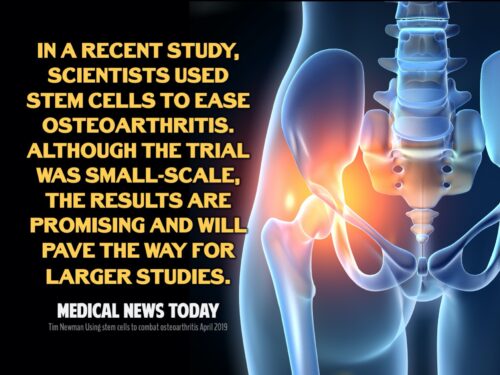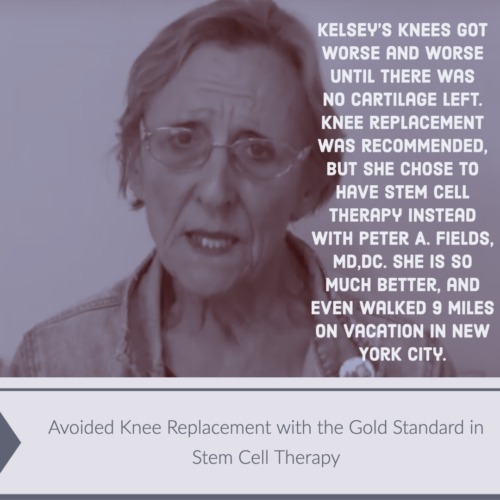Stem Cell Therapy has become a popular treatment and one that can provide very satisfactory results. And Stem Cell Therapy for arthritis, including the repair of degenerated arthritic joints, offers many promising possibilities.1 Stem cells have been shown in research to speed up and enhance bone and cartilage repair in arthritic joints.2,3 Since surgery comes with many disadvantages, Stem Cell Therapy to repair defects of articular cartilage provides an exciting alternative.
Another fascinating research finding involves evidence of the reduction in the usual progressive destruction of articular cartilage in arthritic disease by mesenchymal/bone marrow stem cells. Bone marrow stem cells appear to suppress inflammation and release growth factors that combat arthritis and the degenerative process, enabling healing mechanisms to repair articular cartilage and relieve the chronic pain of arthritis.

Stem Cell Therapy Effective for Osteoarthritis
Have you looked into Stem Cell Therapy for arthritis relief? It’s important to do your homework when it comes to Stem Cell Therapy because not all treatments are alike. You may have seen treatments advertised that may involve just one injection of stem cells. One injection is most likely insufficient to provide an adequate repair of the joint and the pain relief you seek.
Joint injuries, like those that eventually lead to arthritis, generally involve the entire joint. If one ligament is injured, there’s a huge likelihood that other ligaments or soft tissue are also injured. And these other areas need to be treated too. One injection simply cannot treat the entire joint.
When the supportive joint structures, such as ligaments and other soft tissue are healthy and strong, they prevent abnormal joint motion. But when they become injured, the joint will move in an abnormal pattern, injuring other joint structures, and eventually leading to joint destruction and arthritis.
The degeneration and breakdown of cartilage that is evident in arthritis is something that transpires over time. It doesn’t just appear immediately. The beginning is often an initial injury that begins a process of instability in the joint with movement in the joint that is abnormal. This joint instability then becomes the source of further joint injury. And it causes pain too.
Joint instability also involves loose, weakened, and unsupportive ligaments. In essence, the whole joint becomes affected. To achieve repair of the entire joint, the supportive structures surrounding the joint need to be treated, as well as the degenerated structures inside the joint. Intra-articular injections during Stem Cell Therapy for arthritis, combined with the growth factors in treatments like PRP and Prolotherapy can improve cartilage quality in arthritis, repair the injured soft tissue, and resolve joint pain.

A comprehensive treatment is necessary to strengthen, repair, and stabilize ligaments and structures of the joint to prevent destructive forces from continuing the breakdown of cartilage common in arthritis.
A single injection is simply not comprehensive enough to reverse the damage affecting the entire joint. In our practice, we address these unnatural hypermobile forces with a multi-injection technique called Comprehensive Regenerative Orthopedics. It’s a very effective Stem Cell Therapy for arthritis repair and pain relief.
Our Stem Cell Therapy for arthritis treatment involves the use of four different regenerative therapies. Two sources of stem cells (bone and fat), as well as PRP Prolotherapy and Dextrose Prolotherapy. The supportive joint structures, the inside, and the outer structures of the joint are all treated. This is considered The Gold Standard for Stem Cell Regeneration.
At OrthoRegen, our Stem Cell Therapy for arthritis is different than at other clinics. What makes us different? Many other clinics only use one or two of the above procedures, but not all four. All solutions are centrifuged and concentrated to obtain a solution with the most concentration of stem cells. In our experience, we have discovered that this technique is the best for regeneration. We inject both of these sources of stem cells and then combine the use of PRP Prolotherapy to accelerate their healing.
In addition, we apply Dextrose Prolotherapy to the outside supportive structures of the joint to help stabilize the ligaments and tendons that hold the joint in place. We utilize this style of treatment because it addresses the whole joint and not just the effect. That is why it is considered the Gold Standard.
Amniotic Stem Cells are being advertised all over the place and people are fascinated with this very popular trend of using amniotic fluid for joint repair. But it needs to be clarified that Amniotic “Stem Cell” Therapy has NO actual stem cells, but rather growth factors found in the extracellular matrix of the amniotic tissue.
Companies purchase the afterbirth materials, process it to remove disease, and then freeze-dry it. Understandably, the process preserves the fluid, but it also kills the live cells. What’s left are healing growth factors. NO live stem cells are present. Therefore, if claimed as such, it is simply not the truth.
In their pre-donated state, amniotic fluid does have an abundance of stem cells, but they do not survive the processing. Many people leave stem cell seminars convinced that their own stem cells are no good and that donated amniotic “stem cells” will help them with their chronic joint pain from arthritis. It’s important to understand that cryopreserved, dehydrated amniotic products do not contain stem cells. It’s also important to understand that bone marrow, even in elderly individuals with arthritis, does have sufficient stem cells, and the cells are alive! Additionally, your own blood in the form of Platelet Rich Plasma (PRP) contains live growth factors. Yes, purchased, micronized amniotic fluid does contain growth factor material, but it is processed. Why not just use your own (autologous) live stem cells and PRP growth factors for your arthritis pain?
Arthritis is a chronic, progressive disease of the articular joints, which to date, has had no cure or effective long-term treatment. However, Regenerative Injection Therapies like Stem Cell Therapy, Platelet Rich Plasma, and Prolotherapy have already been proven to work well to effectively activate cells for regeneration and repair in degenerated arthritic joints. Regenerative Orthopedics is an effective option for treating arthritis with the potential for enhancing the quality of life of individuals with the disease.
Click here for more articles by Dr. Fields
1. Chahal, J., Gómez-Aristizábal, A., Shestopaloff, K., Bhatt, S., Chaboureau, A., Fazio, A., Chisholm, J., Weston, A., Chiovitti, J., Keating, A., Kapoor, M., Ogilvie-Harris, D.J., Syed, K.A., Gandhi, R., Mahomed, N.N., Marshall, K.W., Sussman, M.S., Naraghi, A.M. and Viswanathan, S. (2019), Bone Marrow Mesenchymal Stromal Cell Treatment in Patients with Osteoarthritis Results in Overall Improvement in Pain and Symptoms and Reduces Synovial Inflammation. STEM CELLS Translational Medicine, 8: 746-757. https://doi.org/10.1002/sctm.18-0183
2. Wakitani S, Goto T, Pineda SJ, Young RG, Mansour JM, Caplan AI, Goldberg VM. Mesenchymal cell-based repair of large, full-thickness defects of articular cartilage J. Bone Joint Surg. Am. 1994;76:579-92.
3. Burke J, Hunter M, Kolhe R, Isales C, Hamrick M, Fulzele S. Therapeutic potential of mesenchymal stem cell-based therapy for osteoarthritis. Clinical and translational medicine. 2016 Aug 10;5(1):27.